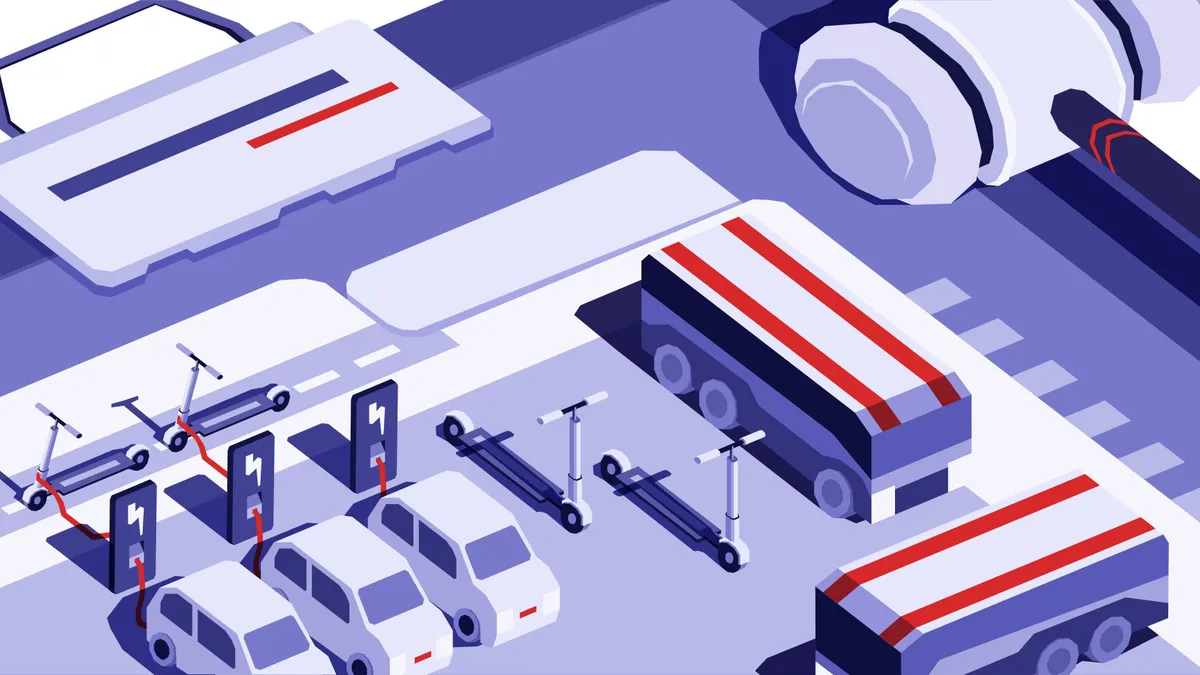Dive Brief:
- In its 2020 cost-savings white paper, charging-as-a-service provider Amply Power used a dollar-per-gallon equivalent (DPGe) to help fleet operators nationwide compare gasoline/diesel costs versus EV charging costs in major metropolitan areas.
- Running medium-duty electric vehicles (EVs) saves on energy costs in 21 of the 25 largest U.S. cities, including Los Angeles, San Francisco and Seattle. In Atlanta, Boston, Detroit and San Antonio, running EVs is more expensive than fleets with internal combustion engines, the paper says.
- The comparison comes as electric trucks and other vehicles are poised for continued growth, despite the current pandemic. "Medium and heavy-duty fleets are the next frontier in vehicle electrification," Paul J. Allen, senior vice president with M.J. Bradley & Associates, told Utility Dive.
Dive Insight:
As states and metropolitan areas set targets for reducing greenhouse gas emissions, commercial and municipal fleet operators need clear energy pricing, according to the white paper.
"The emissions from Class 2b through Class 7 and 8 trucks are much higher than those from gasoline-powered passenger vehicles," which would make them the obvious choices for electrification in states and localities with with greenhouse gas reduction targets, Allen said.
However, manufacturers have hesitated to produce medium and heavy-duty electric vehicles until there are clearer demand signals from fleet operators, according to Allen.
In addition, there are challenges to fleet electrification beyond vehicle availability, an environmental advocate said.
"The two challenges to fleet electrification are infrastructure and rate design and those go hand in hand," Miles Muller, attorney with the Natural Resources Defense Council's Climate and Clean Energy Program, told Utility Dive. "The important thing is to recognize the significance of rate design to commercial fleets."
Amply's charging-as-a-service uses a per-mile-driven pricing model for its managed charging solution for commercial and municipal fleets, the company explained in its white paper. The company's DPGe calculations allow fleet operators to make mile-for-mile comparisons of electric fueling costs versus gasoline/diesel fueling costs across each metropolitan area.
EVs are the clear winners in Pacific Coast cities, according to Amply's calculations. But fleet operators would lose money if they charged medium or heavy-duty electric trucks in Detroit — managed charging is 90% more expensive than diesel for medium duty trucks there and 47% more expensive for heavy duty trucks.
Utility billing for vehicle charging can include energy charges, demand charges calculated using the single highest spike in energy use during the month, and fixed charges allowed by utility regulators, according to the white paper. A few utilities offer EV-specific rates that contain no demand charges, but some EV rates are temporary and demand charges may resume.
"Utilities must recognize the need for reform in rate design," NRDC's Muller said, pointing to the examples of Pacific Gas & Electric (PG&E), Southern California Edison (SCE), and San Diego Gas & Electric (SDG&E) in California, where utilities have committed to a $700 million investment in electrification of medium and heavy-duty fleets.
In its white paper, Amply urges fleet operators, regulators, utilities and its competitors to cooperate on establishing conditions that support the transition to fleet electrification, including calling for:
- Fleet operators to commit to an EV fleet transition plan and push their peers to find the real economic value in EV fleets;
- Utilities and regulators to carefully craft their policies and rates to bring down costs, looking to the examples of PG&E, SCE and SDG&E in California, along with Xcel Energy in Colorado, who have all implemented EV-specific rates; and
- Amply's competitors to design their businesses to generate real, intentional and sustainable value to their clients, the energy system, and society.
"Commercial vehicles are just starting to electrify," Nick Albanese, head of BloombergNEF's intelligent mobility team, told Utility Dive in an email. "BNEF predicts 10% of light-duty commercial vehicle sales will be electric by 2025 and that 30% will be electric by 2030."












